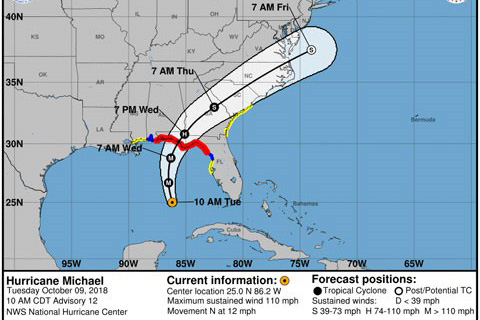
Summary
|
The National Hurricane Center’s cone of uncertainty, pictured here before Hurricane Michael slammed the Panhandle, are among the forecast products this team plans to improve. Members of this team plan to develop new forecast products to communicate the risks and potential threats of approaching tropical storms and hurricanes, especially to underserved populations who, because of limited resources for adequate preparation and recovery, often bear a disproportionate burden of these natural disasters.
During the first phase of their project, researchers on team HURAKAN, named for the Mayan and Taino god for hurricanes, studied relevant literature and held focus-group sessions on the National Hurricane Center’s most-viewed and requested forecast products—particularly the cone of uncertainty. Reflecting the uncertainty in the probable track of the center of a tropical cyclone, the cone, researchers noted, “is easily misinterpreted and provides limited information about multiple hazards.”
“Some of the confusion is due to the probabilistic concepts presented in the forecast, the vast amount of information to process, and specific graphic elements that violate design guidelines,” the team led by Barbara Millet, research assistant professor in the School of Communication, wrote about the cone. “Participants were specifically interested in receiving clear information that would help them make informed decisions about what to do and when.”
To that end, the team plans to collaborate with the hurricane center on designing new forecast products that communicate “the minimal critical pieces of information to the maximum number of people from diverse backgrounds.” They also plan to develop a “best practices” guide that will be applicable to a range of natural and technological hazards.
|
Phase I (2018)
|
Named for the Mayan and Taino god for whom the word hurricane is derived, this proposal draws from a number of fields—including meteorology, environmental anthropology, decision science, and community engagement—to address a critical gap in visual hurricane forecast products: making them easily understood by the public, particularly in underserved communities.
“The goal isn’t to change how forecasts themselves are made, but how these forecasts, which are based on complex analyses and models, can be effectively conveyed to the general public so citizens can make the right decisions in terms of protecting their lives and property,” said team member Alberto Cairo, assistant professor in the School of Communication, who noted the familiar but often confounding cone of uncertainty will be among the many elements of the team’s exploration.
“We believe that the public often misunderstands the visuals used to present this kind of information to them, so we hope this project will provide some advice on how to improve them,” he said.
|
Team
|
Barbara Millet, Communication; Alberto Cairo, Communication; Kenny Broad, RSMAS; Scotney Evans, Education and Human Development; Sharanya Majumdar, RSMAS. |




